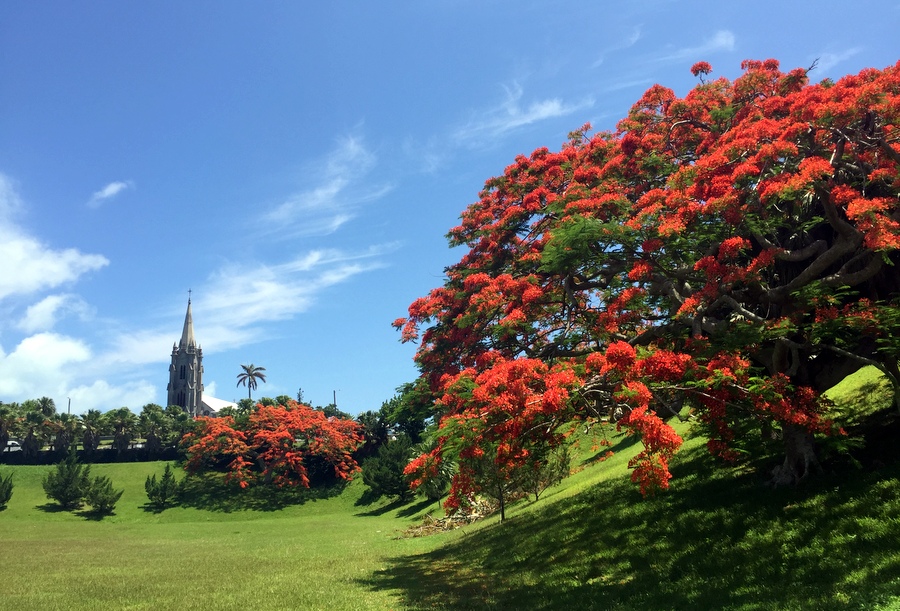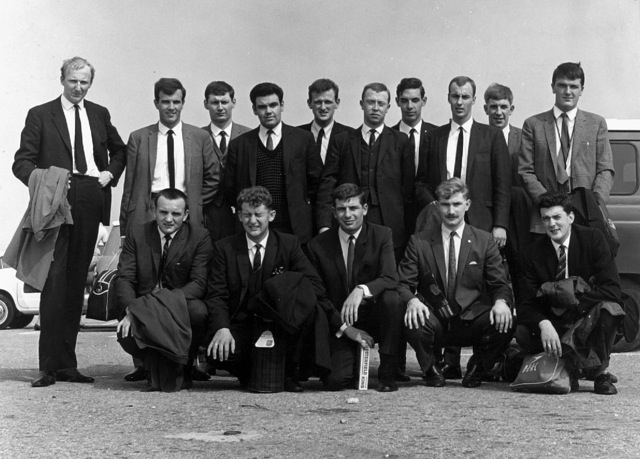The Twist in a Tale of Two Intruders

This article has kindly been submitted to our ExPo website by retired Superintendent George Rose who has written a series of interesting articles arising out of cases he was involved with during his career in the Bermuda Police Service. We are always delighted to receive such articles so if you dealt with a case that you think might be of interest to your former colleagues, please don't hesitate to submit it to us for publication
You will read below how a routine examination of the facts surrounding a report of breaking and entering quickly evolved into an interesting and unusual set of circumstances.
At 9.00 a.m. Saturday 17th February 1968 in company with scenes of crime officer DC Ron Wallace I went to a residence in Friswells Hill, Pembroke and commenced enquires into a complaint of a breaking and entering which had occurred earlier that morning. I there learned that at about 2.05 a.m. the elderly complainant and his wife had been awakened from sleep by the sound of breaking glass and a disturbance in their front living room. Upon investigation complainant discovered a white American male standing in his front living room. Complainant saw that his window glass had been broken, the window had been lifted and the fly-screen was lying on the living room floor.
The American intruder then walked to the front door and let into the house another man, also an American, who appeared to be in a dazed condition and who was cut about the head. This man sat down on the couch and appeared to fall asleep. Both men seemed to be frightened and told the complainant:
“Someone is chasing us.” – “Don’t you know there is a war on outside?” – “Don’t turn the lights on.” – “It’s alright John I’ll get your head fixed.” – “We have to get back to N.O.B. it’s about a 5 mile swim.” – “Don’t let them see us.”
Shortly thereafter, the complainant’s wife joined her husband in the front room bringing a torch with her. She was allowed to return to the bedroom to collect their dressing gowns but she was followed and watched by the first American. She then went to the kitchen to ‘phone the police but this same American either fell against or tripped over the telephone line and ripped it out of its socket. He swore profusely but was non-violent and did not assault either of the complainants.
Both Americans were bleeding from cuts. The first man from a cut at the back of his right hand sustained when he broke the window to gain entrance to the house; the other from a cut at the back of his head, sustained sometime earlier. Both men asked the lady of the house to dress their cuts and this she did.
Complainants’ were able to give a good description of both men who had remained in the house for about 20 minutes. They described them as being frightened and they appeared to have been drinking. They were white Americans. Apart from general commands delivered to the complainants the men were never threatening nor did they seem malicious in nature. The house remained in darkness and the men were alert to any movements outside.
Just prior to leaving the house, the first American took a wallet from his pocket and showed a US Naval Identification card to the complainants’ who were unable to read the name thereon. Both men then left the house running down towards Parsons Road and taking with them the torch belonging to the complainants. The house was without a working telephone causing the male complainant to leave the house and call police from a public telephone kiosk nearby. The police were not able to attend immediately due to being otherwise engaged with street disturbances in nearby Hamilton.

Continuing with follow-up enquiries, at 11.30 a.m., together now with Detective Sergeant Sean Sheehan, I went to the Naval Operations Base (N.O.B.), Southampton where enquiries led us to the USS Sturgeon, a nuclear-powered fast-attack submarine (SSN 637). We there interviewed the Executive Officer Lt. Cmdr. Bruce DeMars who told us that at about 3.30 a.m. that morning he had been awakened by two of his men returning to the submarine. They had awakened him in order to tell him that they had been involved in some trouble during the night somewhere near Hamilton City. The Commander saw that both men were bleeding from cuts, one to the head, and the other to the back of his right hand. Both men were immediately treated by the ship’s doctor.

SSN 637
The commander identified these men as John F.…. (20) a machinist’s mate 2nd Class and Benjamin E ……(22) an electrician’s mate 2nd Class – both of the USS Sturgeon. The commander spoke highly of both men as being good sailors and citizens and said they had told him the whole story of what they had done. The Commander was unable to raise any of his legal advisors but allowed us to interview the two sailors in his presence. He asked that no statements should be recorded.
At 1.00 p.m. that day on board the USS Sturgeon we interviewed machinist’s mate John F…… who stated that in company with his friend Ben E...... he had been drinking in Hamilton. He said that at about 1.30 a.m. whilst walking along a street in the city they had been chased and Ben E…… had been assaulted with a thrown bottle. They had both run and he had dragged his injured friend for much of the way due to his dazed condition after being hit on the head with the bottle. Finally, they had collapsed on a lawn outside a house and he had broken into the house to escape further injury from a crowd who was chasing them. He further said that he had given the male householder US$10 to cover the damage done to the house. John F…. returned to me the torch he had run off with from the residence.
When interviewed, Ben E…..told the same story. He said he had been semi-conscious at the time and had depended on his friend to help him. I saw a large swelling on the back of E’s head consistent with an assault by a bottle.
Their stories checked with the facts in our possession except for one point. They had told their commander that they had paid the male complainant US$10 to cover the damage done to the house window. The complainant had made no mention of this alleged payment during my earlier interview with him.
I then drove Lt. Cmdr. DeMars from N.O.B. to the complainants’ residence where he apologized to them on behalf of his two sailors for the fright and inconvenience caused to them earlier that day. It was only then that I learned from the male complainant that he had received US$10 from John F……. The complainant apologized for not having told me of such when first interviewed. I returned the torch to the complainant and he expressed total satisfaction with the apology and for the police action in this matter. He wished the matter to rest at that.
As reported below, it is a fact that a serious street disturbance involving about 150 persons had taken place in Hamilton during the early hours of that morning. Both sailors, on leaving the Hog Penny Bar, on Queen Street had walked in a northerly direction. It is entirely likely that they had walked into the remnants of the earlier street disturbance and had been chased. It is equally possible that they had been mistaken for plain-clothed police officers since both matched the size and stature of such and both had been dressed in civilian clothing. The Island is completely strange to both men.
There is no evidence of a malicious or felonious intent by these sailors and their actions appear to have been motivated solely by fear and panic. Both men had freely admitted their role in this matter. After consultation with both DCI Sheehy and Commander DeMars it was agreed that there should be no further police action. The complaint was filed as a No True Case of crime.
The reported street disturbance – occurring as it did some six weeks prior to the April 1968 (Easter Flower Parade) riots – was described as follows by The Royal Gazette on Monday, February 19, 1968.
Court Street Fracas Worst Since February, 1965, Riots – Police
“Tear gas was used by the police for the first time in three years early Saturday morning to control a Court Street mob of about 150 bottle, stone and Molotov cocktail-throwing people who had collected to watch a fight between two men but then turned on the police. The police, who prefer to call the fracas an incident rather than a riot, agreed, however, that it was the worst incident since the rioting outside the Bermuda Electric Light Company plant on Serpentine Road in February, 1965.
12.40 A.M.
“The trouble apparently began at about 12.40 a.m. with a two-man fight on Victoria Street outside the Ex-Artillerymen’s Association. There was a rumour that the fight had actually started inside the club and worked its way outside to the street, but club officials vigorously denied this. The police were called in and by the time they arrived there was a small street crowd watching the fight. But the crowd, who drifted off Victoria Street and into Court Street, quickly grew into an angry mob of about 150 people who began throwing stones, bottles and Molotov cocktails at the police.
ONE ARRESTED
“No one was injured in the fracas but the police arrested one man who they said will probably be appearing in Hamilton magistrates’ court shortly. The police said that the incident lasted for about an hour and 20 minutes and that by 2 a.m. things had pretty well calmed down but a taxi-driver, Mr. Eugene T…. of Crawl Hill, who was driving through the area at about 2.40 a.m. reported that one side of his car was dented by a stone or bottle thrown at the vehicle.
“About 20 to 30 policemen had been called to the scene. They were not a riot squad as such, said a police spokesman, although the men did have some special equipment including tear gas for dealing with this kind of situation.
TEAR GAS
“The police were forced to use tear gas to control the crowd, but only a small amount of the gas was used, said the spokesman. This was the first time it had been used since February 2, 1965, he said. Asked if this was not the largest disturbance since 1965, the spokesman said, “Yes, I suppose that is a fact when you put two and two together.”
The tear gas was used by the police to quell the disturbance while avoiding injury on both sides, which was effectively accomplished, he said.
“The policed spokesman said he did not know what caused the incident in the first place. “This is something that was spontaneous – it was not an organized thing,” he said.
REASON UNKNOWN
“Asked why the crowd should suddenly turn on the police, the spokesman said,
“We can’t put our finger on why they should do this at the moment.” Apparently the crowd just didn’t like the idea of the police coming in although the police had in fact been called in, he added.
[The vice-president of the Club expressed his concerns about the fight having starting in the club. He said, “The fight started outside on the street. No fighting started in the club at all.” He had no idea what caused the disturbance but Club officials were looking into it.]













